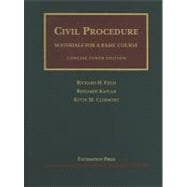Civil Procedure

Civil Procedure
- ISBN 13:
9781609300111
- ISBN 10:
1609300114
- Edition: 10 Concise
- Format: Hardcover
- Copyright: 05/11/2011
- Publisher: Foundation Pr
Rent
Sorry, this item is currently unavailable.
Note: Supplemental materials are not guaranteed with Rental or Used book purchases.
Extend or Purchase Your Rental at Any Time
Need to keep your rental past your due date? At any time before your due date you can extend or purchase your rental through your account.
Summary
This casebook is the Concise, and very modern, Edition of a respected classic of civil procedure casebooks. The key to its brevity is its step-by-step surveyof the subject in Part One. This survey is more than an introduction. It suffices to give the students a complete and solid grounding in civil procedure. There is a tight 250-page comprehensive treatment of modern civil procedure, comprising cases and commentaries and text and questions that progress from pretrial to settlement to trial to judgment to appeal to jurisdiction to complex litigation. In our casebook, brief yet thorough coverage can be effected through its efficient and systematic step-by-step survey. The survey in the Concise Edition has been somewhat beefed up to compensate for the omission of full chapters on pretrial, trial, appeal, and complex litigation. Moreover, the Concise Edition has been revised to account for changes in the law since the casebook''s Tenth Edition emerged last year. Although special topics receive coverage slightly different from that in the Field, Kaplan & Clermont casebook''s complete version, the intention remains to give them full and solid treatment. Conciseness is achieved by selecting a limited number of topics rather than by retaining many topics in senselessly compact form. Teachers of civil procedure have widely shared goals. First, we want students to perceive the essence and ultimately the thematic coherence of the adversary system prevailing in U.S. courts. Second, we want to convey an understanding of the constitutional and legal structure in which those courts operate. Third, we believe that the whole course serves another purpose, namely, to develop a sense of the importance of any given procedural system in constructing the surrounding body of substantive law. The Concise Edition''s retained core of materials allows accomplishing these goals efficiently. The materials'' arrangement allows accomplishing the goals effectively. By utilizing the survey the teacher can fulfill the responsibility of getting across the essential information, while reserving enough time to do the more significant and palatable. However, the structure of the casebook is not a strait jacket. Some teachers especially newcomers to the casebook who are not yet comfortable with Part One?might prefer to begin with the jurisdictional materials. The suggestion of flexibility in pursuing the overall aim does not mean that the book arrives with no thought behind the order of materials. Nor does the emphasis on brevity alone explain resort to a survey method, as a simple-minded concession to the press of time. A pedagogic theory definitely lies behind the book. This casebook''s solution is not to find a seam, but to present the whole. Part One of the casebook in fact provides a series of three concentric overviews of increasing breadth and depth. Each is small enough in scope for the students to absorb when they reach it, but each stretches their minds sufficiently to prepare them for the greater effort of assimilating the succeeding materials. The casebook''s approach, then, is to present the subject of civil procedure to the students in a series of waves, each successive one of greater sophistication. This allows the students to understand far more broadly and to probe far more deeply than an approach that seemingly goes neatly from area to area in covering the law of civil procedure without any doubling back. Moreover, the casebook''s approach is much more effective at addressing another major problem in teaching basic civil procedure: the latency of values that marks the subject. Only after some time and con?siderable effort can the students perceive and weigh the fundamental values at play in any area of procedure. It would be a shame to complete the study of a particular area before the students were prepared to begin that study. One decision made by the editors in seeking conciseness was to include five (heavily edited) stories from the acclaimed Civil Procedure Stories (2d ed. 2008). The story of Hickman or the story of Hansberry can work wonders at quickly conveying a sense of a whole field such as pretrial discovery or class actions. At the same time, pausing for a while on one case can do a lot to counter the modern teaching tendency to rush through cases in order to lecture on the rule of the case. The teacher faces lots of temptations to go in that direction, in the pursuit of speedy coverage of the vast and rich subject and in the pursuit of delivery of knowledge rather than creation of understanding. The story method is an antidote. Studying a selected few cases with special care, criticism, and activism best allows the student to create that understanding. Inclusion of a few stories fits with the Concise Edition''s mission of delivering a compact book for short courses that does not entail substantial pedagogic sacrifices, but indeed may lead to teaching an even better course.






